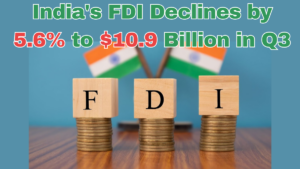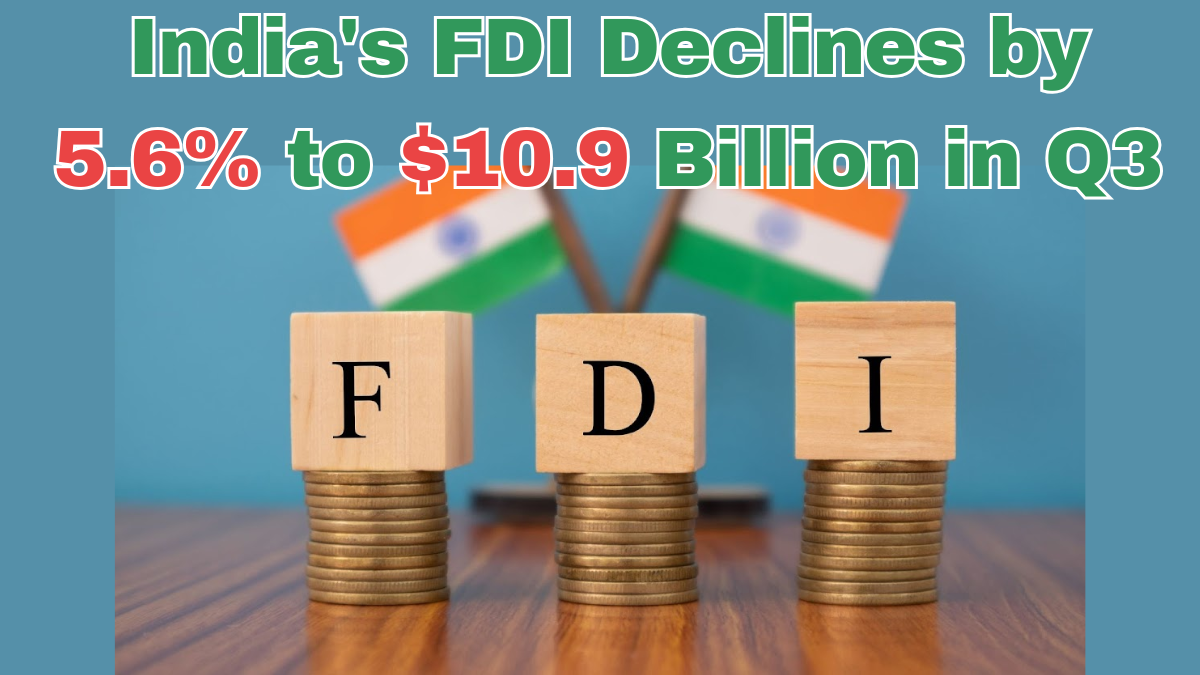India’s Foreign Direct Investment (FDI) inflows have witnessed a decline of 5.6% in the October-December quarter, dropping to $10.9 billion, according to recent reports. This drop in FDI comes as a surprise given India’s status as one of the world’s largest emerging markets. In this article, we explore the factors behind this decline, the sectors affected, and the potential impact on India’s economy.

Understanding the FDI Decline
FDI has always been an essential contributor to India’s economic growth, helping to bridge the investment gap, create jobs, and boost technology transfer. However, the latest quarterly data reveals a drop of 5.6% in FDI compared to the same period the previous year. Despite India’s favorable demographic profile and its position as a global economic powerhouse, several factors have contributed to this downturn.
Key Reasons for the FDI Decline
-
Global Economic Uncertainty: Global economic conditions, including geopolitical tensions, inflationary pressures, and rising interest rates in several major economies, have made investors more cautious. The uncertainty surrounding global supply chains and the ongoing impacts of the pandemic have likely contributed to this decline in FDI.
-
Slower Economic Recovery Post-Pandemic: While India’s economy is rebounding, the pace of recovery post-pandemic has been slower than expected. Challenges such as inflation and a tightening monetary policy could have dampened investor confidence in certain sectors of the economy.
-
Sector-Specific Issues: Certain key sectors, including manufacturing, construction, and services, have experienced slower growth or lower investor interest. This has affected the overall FDI inflows into India, which is traditionally a major recipient of foreign investments in sectors such as information technology, pharmaceuticals, and telecommunications.
-
Investment Shifts to Other Emerging Markets: Investors have increasingly shifted focus to other emerging markets, particularly those in Southeast Asia, due to more favorable business climates, lower operational costs, and government incentives. This diversification of investment portfolios may have also contributed to the decline in India’s FDI.
Key Sectors Affected
Certain sectors, which have historically been major recipients of FDI, have seen a drop in foreign investment:
-
Services Sector: The services sector, which includes information technology, telecommunications, and financial services, traditionally attracts a significant portion of FDI in India. However, due to various global challenges and slowdowns in demand, this sector has been affected by reduced inflows.
-
Manufacturing: India’s manufacturing sector, despite government initiatives such as “Make in India,” has struggled to attract the same levels of foreign investments it once did. Issues like regulatory complexities, labor market challenges, and infrastructure bottlenecks have deterred foreign investors in this area.
-
Real Estate: The real estate sector, which has historically seen steady FDI, also experienced a slowdown in investments. This is primarily due to changes in global investment preferences, regulatory hurdles, and slower growth in the Indian housing market.
Impact on India’s Economy
The decline in FDI may have several short-term and long-term implications for India’s economy:
-
Impact on Job Creation: FDI is a crucial source of job creation, especially in sectors like technology, manufacturing, and services. A decline in FDI may slow down job growth in these areas, particularly for skilled labor.
-
Technology Transfer and Innovation: FDI brings not only capital but also new technology, expertise, and management practices. A reduction in FDI may result in slower technology transfer, which could hinder innovation and the overall competitiveness of India’s economy.
-
Impact on Infrastructure Development: FDI plays a significant role in funding infrastructure projects, including transportation, energy, and urban development. A decline in foreign investment may lead to slower progress in upgrading the country’s infrastructure.
-
Government Response: The Indian government has been working on measures to attract more foreign investment, including simplifying the FDI regulatory process and offering incentives for greenfield and brownfield investments. However, the slowdown in FDI suggests that these measures may need to be further strengthened.
What Can India Do to Boost FDI?
-
Improved Regulatory Environment: India needs to further streamline its regulatory framework and reduce the complexity of doing business to attract more foreign investors. Simplified rules and faster approval processes can encourage FDI inflows.
-
Targeted Policy Measures: Specific sectors like renewable energy, electric vehicles, and advanced manufacturing should be targeted for FDI through government incentives and subsidies, as these areas show strong growth potential.
-
Infrastructure Development: Improved infrastructure, including transportation and logistics, will make India a more attractive destination for foreign investors, particularly those in the manufacturing and logistics sectors.
-
Skill Development: Ensuring a skilled workforce through better education and training programs will help address labor shortages in certain sectors, making India an even more attractive investment destination.
Conclusion
While the 5.6% decline in FDI in India during the October-December period is concerning, it is not entirely unexpected given the global economic uncertainty and specific challenges within India’s key sectors. However, with the right policy measures, India can turn the tide and continue to attract substantial foreign investments in the future. The Indian government’s efforts to streamline the investment process, improve infrastructure, and encourage innovation will be essential in maintaining the country’s position as one of the world’s most attractive investment destinations.
Frequently Asked Questions
Why did FDI in India decline?
FDI in India dropped due to factors like global economic uncertainty, slower post-pandemic recovery, and sector-specific challenges.
Which sectors were most affected by the FDI decline?
The services, manufacturing, and real estate sectors experienced a reduction in foreign investments.
How can India boost its FDI inflows?
By improving the regulatory environment, offering targeted incentives, investing in infrastructure, and focusing on skill development, India can attract more FDI.
What is the impact of reduced FDI on India’s economy?
A reduction in FDI can slow down job creation, technology transfer, infrastructure development, and overall economic growth.
What measures is the government taking to attract more FDI?
The Indian government is working on simplifying the investment process, offering incentives for key sectors, and improving infrastructure to attract more FDI.
Click here to learn more.
Pari is a passionate writer known for captivating stories that blend imagination and reality. Inspired by travel, history, and everyday moments, Pari crafts narratives that resonate deeply with readers.
